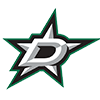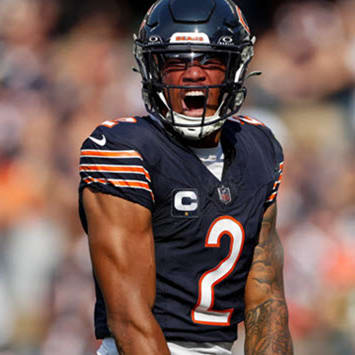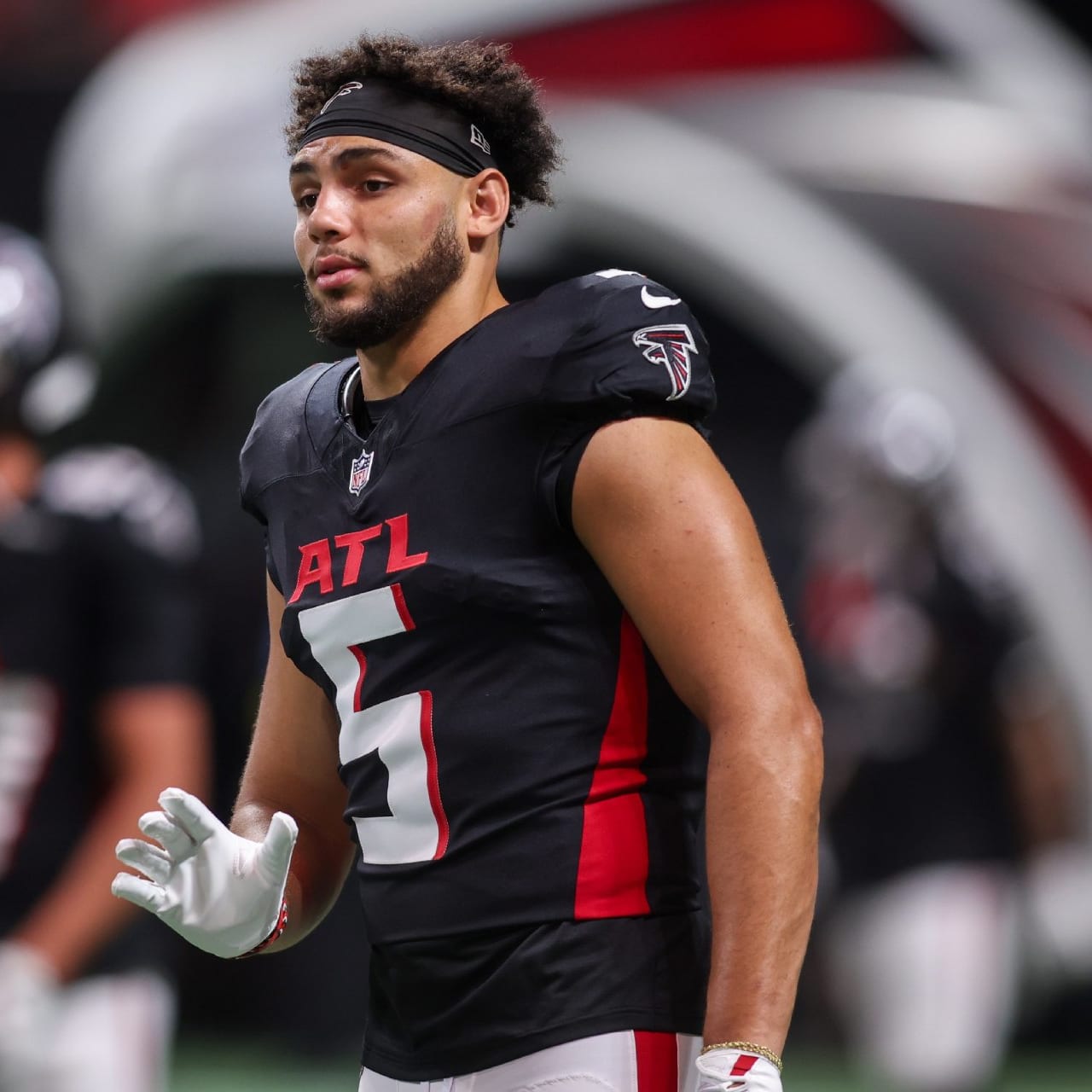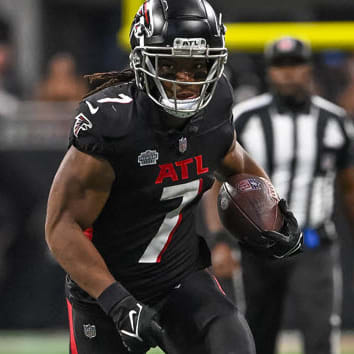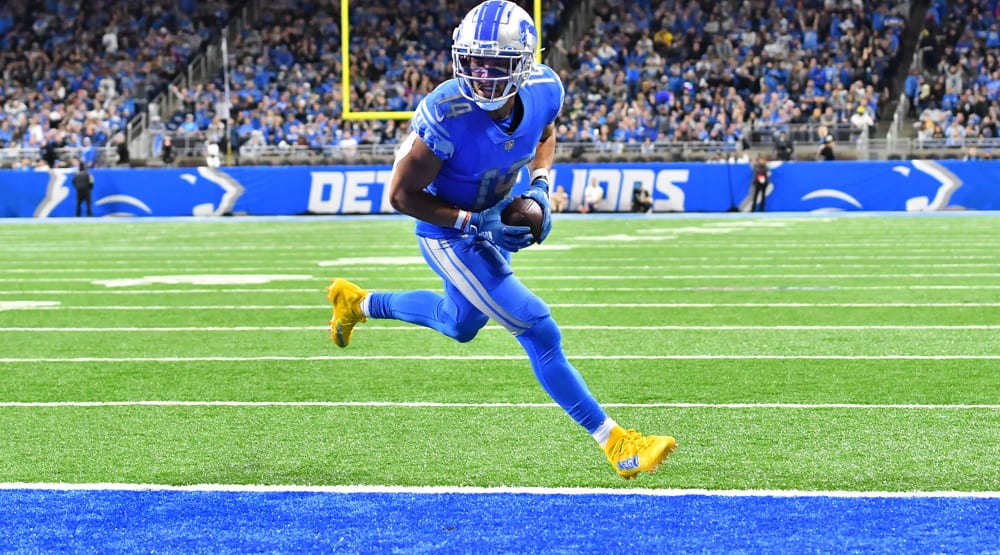You can view the QB rankings article by clicking here, and you can view the RB rankings article by clicking here.
This article will go through top 25 rankings for the 2023 wide receiver class, including a round projection for each of the top 25. There is a short list of honorable mentions at the end.
- Jordan Addison, USC (6-0, 175)
Addison is awfully convincing. He produced at a blistering rate from Day 1, catching 60 passes for 666 yards and four touchdowns on 89 targets (67.4 percent catch rate, 7.5 YPT), leading Pittsburgh in all receiving categories as a true freshman despite missing one game. Addison established himself as an NFL prospect with those 10 games alone. He was just getting started, though.
Aside from COVID, the main reason Kenny Pickett ended up a first-round pick was the remarkable effort Addison put forth as a sophomore in 2021. Addison caught 100 passes for 1,593 yards and 17 touchdowns on 145, good for an unreal 11.0 yards per target on a 69.0-percent catch rate. Not just that, but Addison carried a mammoth 33.7 percent share of Pittsburgh's receiving yardage. To produce at that volume level with that absurd efficiency would be impressive at any age, with any quarterback. Addison was 19 at the time, and he was catching passes from Pickett. This is not a player to question.
Projected round: 1 (Top 15)
2. Jaxon Smith-Njigba, Ohio State (6-1, 200)
Smith-Njigba was the primary slot receiver in the 2021 Ohio State offense, which of course featured Chris Olave and Garrett Wilson. As a true sophomore in his age-19 season, Smith-Njigba managed to keep up with Olave and Wilson in their age-21 seasons. Olave and Wilson emphatically vouch for Smith-Njigba, too. If you can keep pace with receivers like Olave and Wilson, you can only be so bad. Similarly, just because you play the slot in an offense with those guys outside doesn't mean you can only play the slot. Justin Jefferson played the slot at LSU, and obviously he's had no trouble playing outside in the NFL.
Then again, Jefferson proved he had the speed to play outside when he ran a 4.43-second 40 at the combine. Smith-Njigba similarly has quite a bit at stake with his workout metrics. If he has sub-4.5 speed then Smith-Njigba should be able to run routes credibly from both the boundary and slot. If he runs a 4.6 or worse then his profile would more so begin to resemble Amon-Ra St. Brown. St. Brown fell to the fourth round of his draft but that obviously has not aged well.
Projected round: 1
3. Quentin Johnston, TCU (6-4, 215)
Johnston is arguably the premier Toolsy wideout of the draft, being much bigger than Addison or JSN even while potentially being the fastest of the three. Johnston also has extremely long arms, which could be an asset in jumpball situations. As a fast wideout with an extreme catch radius Johnston proved a unique big-play threat at TCU, where he did a very good job in all of his three seasons.
There might be more projection to be done with Johnston than in the cases of Addison or JSN, because TCU plays an extremely spaced-out offense with tasks that don't quite resemble what he'll face in the NFL. More specifically, it requires some imagination to envision how Johnston's game might translate to an NFL setting where plays develop more quickly and with less field space to utilize. Even if Johnston isn't a high-frequency target in the NFL, his big-play ability should make him a fantasy standout due to the uncommon yardage and touchdown production he's capable of on a per-target basis.
Projected round: 1
4. Kayshon Boutte, LSU (6-0, 205)
It wasn't long ago that Boutte was widely considered a candidate to be the first wide receiver off the board, but after a turbulent junior year he lost a bit of ground in the rankings. Very few receivers produce at the level Boutte did as a true freshman and sophomore, a span in which he caught 83 receptions for 1,244 yards and 14 touchdowns on 131 targets in his first 16 games. That work alone has him on the first-round radar.
Unfortunately, Boutte wasn't able to help his case in 2022. An ankle injury ended his 2021 and lingered into the spring, but it's not clear if that had anything to do with Boutte's 64.9 percent catch rate at 7.3 yards per target. It was puzzling that Boutte's numbers regressed while the LSU offense overall improved greatly. Sophomore fellow wideout Malik Nabers easily outproduced Boutte, who ideally would do well at the combine to offset the decline his profile has seen in the past year.
Projected round: 1-2
5. Xavier Hutchinson, Iowa State (6-2, 207)
Hutchinson doesn't seem all that explosive and he's not truly big as a wideout, but he thrived as a high-volume target at Iowa State and seems like the type of wideout who excels at landing jabs on a defense, something he did consistently in his three years at Iowa State.
While Hutchinson is a bit over-aged as a fifth-year player, a closer glance at his history shows he does not at all owe his production to his age. We know this because Hutchinson broke out three years ago, his first with the Cyclones as a JUCO recruit. Hutchinson would have likely been 20 years old – about the age by which we'd like an NFL prospect receiver to break out into high-volume, high-efficiency production. Hutchinson did just that in 2020, catching 64 passes for 771 yards and four touchdowns on 92 targets. That's a catch rate of 69.6 percent at 8.4 yards per target, which safely clears the Iowa State baseline of 66.8 percent completed at 7.8 yards per attempt. He comfortably cleared that baseline while providing Iowa State with 26.6 percent of their receiving yardage – more than good enough to grade as Day 2 skill set.
Projected round: 2
6. Tyler Scott, Cincinnati (5-11, 185)
Perhaps this is too high to rank Scott – he's not as accomplished as Josh Downs or Marvin Mims, and he's not as big or hyped as Jalin Hyatt – but his prospect profile looks excellent as long as it doesn't turn out he's like 23 years old already. Scott was a true junior at Cincinnati last year and he produced at a blistering pace, catching 54 passes for 899 yards and nine touchdowns on 87 targets in 11 games. That's a catch rate of 62.1 percent at 10.3 yards per target in an offense that completed 61.0 percent of its passes at 7.9 yards per attempt. Scott torched past the team baseline while providing 31.3 percent of their receiving yardage and 42.9 percent of their touchdowns.
Scott's production unequivocally says he has real NFL starting upside. Scott's athletic testing is likely to indicate the same. According to the Cincinnati player page, Scott is believed to be able to break the 4.30-second mark in the 40. If Scott runs a 4.35 or better it might shock people how high he'd grade as a prospect at that point.
Projected round: 2
7. Josh Downs, North Carolina (5-10, 175)
Downs was primarily a slot receiver for North Carolina and might project for the same role in the NFL, especially if he checks in under 5-foot-10 at the combine. If Downs turns out to be that small then it will put more pressure on his athletic testing. If Downs is 5-foot-9, 175 and runs a 4.50 40, for instance, that would be bad. If he's running a 4.50 we'd want him at least pushing the 190-pound mark.
I mention all of that as a disclaimer, but everything else in Downs' prospect profile is encouraging. The production is the main reason for that. Downs produced at a level of volume and efficiency that is very difficult to imitate with anything less than NFL talent. In his age-20 2021 season Downs drew a whopping 148 targets in 13 games, catching 102 for 1,344 yards and eight touchdowns. His catch rate of 68.9 percent at 9.1 yards per target safely cleared the team baseline of 62.0 percent completed at 8.7 yards per attempt, which is an impressive feat given that he held a 40.2 percent share of North Carolina's receiving yardage. If Downs does well at the combine – think 5-foot-10, 180 pounds with a 4.50 or better – it would be difficult to argue against him in the second round.
Projected round: 2-3
8. Jalin Hyatt, Tennessee (6-0, 185)
Hyatt is very fast and could generate some chatter with his showing at the combine. He already made plenty of noise with his numbers in 2022, a season in which he broke out with 67 receptions for 1,267 yards and 15 touchdowns on 91 targets (73.6 percent catch rate, 13.9 yards per target). That is a ridiculous rate of production – to catch that many targets, for that much yardage per target, while scoring a touchdown once every five catches or less – is a degree of dominance you don't often see. There were a lot of points last year where defenses were completely helpless against Hyatt.
Hyatt is very fast, and he was exceptionally productive in 2022, but that production might be cheapened somewhat by his age and the Tennessee system. Hyatt produced at an incredible level, yes, but he did so in situations he'll basically never see in the NFL. He won't get to line up in the same spots, and he'll need to learn to run more types of routes if he's going to be much more than a decoy. The game was simple for Hyatt in this offense, which basically required him to run in straight lines. Hyatt was a complete afterthought relative to teammate Cedric Tillman in 2021, a season in which Hyatt turned 20 years old. In an age-20 season a receiver should be able to do better than 21 catches for 226 yards and two touchdowns on 36 targets.
Projected round: 1-2
9. Marvin Mims, Oklahoma (5-11, 182)
Mims was never a target monster at Oklahoma -- his career high in receptions was 54 in 13 games last year – but he was so utterly dominant with his targets that it's difficult to look past him. Moreover, while Mims' target and reception counts were never high, he still carried an oversized share percentage of Oklahoma's receiving production.
As a true freshman Mims led Oklahoma in all categories, turning a meager 51 targets into 37 receptions for 610 yards and nine touchdowns. It's easy to miss – 610 yards might not seem like much – but a 72.6 percent catch rate at 12.0 yards per target is a major ass kicking. The sophomore and junior years went almost the exact same for Mims, who turned his next 132 targets into 86 receptions for 1,788 yards and 11 touchdowns, which is a 65.2 percent catch rate at 13.6 yards per target.
Mims is smallish and it's not obvious whether he's fast. The concern for me would be if he turns out to not be fast, in which case it might be difficult for him to access the route depths he was otherwise so great with at Oklahoma. If Mims has 4.4 wheels he should be able to credibly run most of the same routes in the NFL that he did at Oklahoma. I'm plenty open to moving him way up if he tests well enough.
Projected round: 2-3
10. Rakim Jarrett, Maryland (6-0, 190)
Jarrett was one of the top recruits of the 2019 class, a proper five-star get for Maryland. He produced exactly as expected in his first two seasons, keeping pace with then-junior Dontay Demus as a true freshman before establishing himself as Maryland's top receiver as a sophomore. Demus missed seven games that year and might have remained Maryland's lead wideout if he hadn't gotten hurt, but Jarrett still thrived as the lead target, producing above baseline by catching 68.9 percent of his targets at 9.2 yards per target while catching 62 passes for 829 yards and five touchdowns in 13 games. Jarrett fell off a bit in 2022, but he dealt with a concussion and knee issue that could largely explain the regression.
So long as Jarrett tests well athletically – and five-star recruits usually do – he should generate more mainstream recognition as a potential Day 2 pick. If Jarrett disappoints in athletic testing then he might be more of a mid-round prospect.
Projected round: 2-4
11. Parker Washington, Penn State (5-10, 212)
It would be nice if Washington were more obviously fast, because if you're heavy and not fast you're sort of just a bigger target, including for defenders. Being too skinny isn't good either, but at a certain point adding bulk offers diminishing returns if that player can't create the velocity necessary to dictate actual momentum. The recent track record of non-fast, densely-built shorter receivers is maybe not so great at the NFL level – Amari Rodgers one unfortunate recent data point there – but Washington was awfully productive at Penn State and might not be doomed to the same trajectory as Rodgers.
Washington served as Penn State's WR2 behind Jahan Dotson in his true freshman and sophomore years, an impressive feat in itself for a player in his age-18 and 19 seasons. He also produced above baseline in that sample, a detail that carried over to the 2022 season even after Dotson left.
Washington seems unlikely to create separation outside, but he might have the ball skills necessary to threaten more credibly outside and downfield than most other slot-type wideouts. It might be fair to describe Golden Tate as that sort of player, so depending on his athletic testing that sort of ceiling could be on the table for Washington.
Projected round: 2-4
12. Jayden Reed, Michigan State (5-11, 191)
Reed was excellent as a true freshman at Western Michigan in 2018, when he led the team in all receiving categories (catching 56 receptions for 797 yards and eight touchdowns ), including ahead of then-junior Dee Eskridge. Eskridge was an awful pick for Seattle in the second round, but it's still a really good look for Reed to outplay a veteran NFL draft pick as a true freshman. While there are exceptions, and while you admittedly maybe do see such exceptions more often at the mid-major levels like the MAC, it's exceedingly rare for an 18-year-old player to produce at that level and then do nothing at the NFL level.
Reed transferred to Michigan State after that and was able to play beginning in 2020, his age-20.5 season. Reed produced 33 receptions on 56 targets for 407 yards and three touchdowns that year, which trailed in targets (62), yardage (515) and touchdowns (four) to then 21.5-year-old Jalen Nailor, a 2022 sixth-round pick for Minnesota. It would have been nice to see Reed outplay Nailor, but (A) Nailor is a totally competent player and (B) at a year older Nailor should be outproducing Reed. But Reed actually caught more passes than Nailor, and was easily the more efficient of the two. Nailor's greater yardage total came at a high cost – Reed's average of 7.3 yards per target is worth more than Nailor's 8.3 yards per target because Reed's catch percentage was 58.9 percent versus Nailor's 41.9.
Reed's profile lost some of its luster when he was outproduced by true sophomore Keon Coleman in 2022, but it's possible that Coleman is an uncommon talent, which would justify any regression in Reed's production. If Reed tests well athletically there is reason to buy in despite his modest market at the moment.
Projected round: 3-5
13. Michael Wilson, Stanford (6-2, 216)
There might be an injury red flag to consider with Wilson – he was hurt quite often at Stanford – but his production was consistently good and he has one of the bigger wide receiver frames in this draft. He led Stanford in receiving production as a second-year player, and aside from a four-game sample in 2021 Wilson has been reliably above-baseline for Stanford. If he demonstrates standout tools in athletic testing Wilson could really push for Day 2.
Projected round: 3-5
14. Jalen Moreno-Cropper, Fresno State (5-11, 171)
I would rank Moreno-Cropper earlier than this for my personal rankings, but as a skinny small school player there's a pretty good chance Moreno-Cropper will face some amount of skepticism from NFL scouts. JMC's frame is admittedly very light, but it'd take little more than a few fast food orders to get him to the weight of players like Diontae Johnson or Jahan Dotson.
If his frame doesn't hold him back then JMC will succeed in the NFL. He was a menace at Fresno State, where he reportedly chose to play over much bigger programs like UCLA, Oregon, California, Utah and Arizona, and his production at Fresno State no doubt made those bigger programs jealous in the subsequent years. As a motion-heavy slot target he offers a compelling skill set after posting 343 rushing yards on 20 carries as a true freshman and torching as a pass catcher in the three years afterward, catching 205 passes for 2,505 yards and 21 touchdowns on 292 targets (70.2 percent catch rate, 8.6 YPT) in 33 games.
Projected round: 3-5
15. Puka Nacua, BYU (6-1, 206)
Nacua didn't break out until his third collegiate season – his first with BYU after transferring from Washington – but injuries were the reason he didn't break out with his first team. Nacua was one of the top recruits of the 2019 class, and in his six games at Washington he caught 16 passes for 319 yards and three touchdowns on 24 targets. In 21 games at BYU he caught 91 passes for 1,430 yards and 11 touchdowns on 141 targets – a blistering 10.1 yards per target on a 64.5 percent catch rate – and even added 357 yards and five touchdowns on 39 carries. Nacua's history of lower-body injuries might be his main concern.
Projected round: 3-6
16. Zay Flowers, Boston College (5-9, 182)
Flowers gets a lot of hype from most media, including projections as a first-round pick, but I don't see it at all. Flowers was a really good collegiate receiver and could have a useful NFL career, but he's not going in the first round. At 5-foot-9, 182 pounds Flowers is small, which puts a lot of pressure on his athletic testing. While his production is 'good enough,' it's not of a uniquely standout quality. Flowers is likely a slot-dependent receiver in the NFL and one who doesn't obviously project better than recent mid-round slot prospects.
Projected round: 3-5
17. Nathaniel Dell, Houston (5-8, 163)
Dell was super productive at Houston, perhaps primarily due to his blazing speed. It's also possible, though, that his production was so great partially because Dell was playing with an age advantage – he spent two seasons at Alabama A&M before transferring to Houston, so by his Houston debut in 2020 he was in his third collegiate season. Dell produced well that year, leading Houston in receiving yardage, but he was outproduced on a per-game basis by Marquez Stevenson, then a fifth-year wideout and afterward a 2021 sixth-round pick of the Bills. For a third-year player to make a convincing demonstration as an NFL prospect you'd like to see them outproduce a fringe prospect like Stevenson by the third year.
Just as concerning is Dell's frame, which checked in at the Senior Bowl eight pounds heavier than his listed collegiate weight. If 5-foot-8, 163 pounds is the bulked up version of Dell then that bodes poorly for his tools projection as an NFL wideout. Dell looks like a legitimate burner, but if the cost of that speed is a perilously small frame then that speed won't necessarily be useful from scrimmage in practice. Jakeem Grant, J.J. Nelson and Tutu Atwell were all comparably productive players to Dell's Houston production, and Atwell was even a second-round NFL draft pick, but all of them have been limited to gadget and special teams functions in the NFL because their frames simply aren't viable for base offensive functions.
Projected round: 3-5
18. Dontayvion Wicks, Virginia (6-2, 212)
Wicks was excellent in 2021, catching 57 passes for 1,203 yards and nine touchdowns on 95 targets. That was his third season, which is about the time by which you'd like to see a receiver break out to grade conventionally well as an NFL prospect. Wicks' production suffered in 2022 as the Virginia offense struggled overall, but he was voted the best wide receiver on his team in the Senior Bowl by opposing defensive backs. If Wicks runs well at the combine it will go a long way to confirming his viability as a potential starter.
Projected round: 4-6
19. C.J. Johnson, East Carolina (6-1, 225)
Johnson is a player I'd like to list higher because of his upside, but there's not much floor with him so it'd probably be irresponsible to do that. Johnson was mercurial over his four years at East Carolina, reportedly wearing on both coaches and teammates with an unhelpful demeanor, a problem that culminated with a spring suspension in 2022 following unspecified off-field incident. The East Carolina coaches said Johnson was remorseful from that point and was basically reformed, but who knows how the NFL will evaluate Johnson's character.
Johnson seems to work hard – it's difficult to explain how he would have 908 yards in 11 games as a true freshman if he were lazy or practiced poorly – but Johnson seems to be a bit of a hot head and it wouldn't be surprising if he instigated fights in practice or something. Johnson plays angry and mean on the field, where it's an asset, but if he can't enter a workplace without conflict trailing wherever he goes then his talent won't get a chance to play on the field.
But man is that production tempting. As a big, burly receiver Johnson is not quick or fast, but it's probably fair to say he is quick and fast for his size. That size has real utility too: Johnson is not fun to tackle, and he bullies defenders at the catch point. Johnson was a big-play machine at East Carolina because that bullying made him effective on downfield bombs, and that tackle-breaking made him a menace after the catch. If you can threaten credibly on high-ADOT targets and pad underneath yardage by adding yardage after the catch then you always have a big-play option no matter the defensive alignment.
Johnson's talent is real – the question is whether he can convince NFL teams that he's grown up and changed from the immature behavior he showed earlier in his East Carolina career. If he keeps his head on straight Johnson could prove to be something like a rich man's Jauan Jennings.
Projected round: 3-UDFA
20. Cedric Tillman, Tennessee (6-3, 215)
Tillman was exceptionally productive in 2021, but he was less productive in 2022. Those were respectively his fourth and fifth collegiate seasons, meaning he was already at an age when a lot or most top receiver prospects were already in the NFL. That Tillman didn't break out until he had that age advantage over his competition puts more pressure on his athletic testing to grade as a viable NFL prospect.
Projected round: 4-6
21. A.T. Perry, Wake Forest (6-3, 195)
Perry is quite skinny and might not be as fast as you'd like a skinny wideout to be, but he's interesting as a fringe prospect because he appears uniquely quick and coordinated for a wideout as tall as he is. Perry often moves more like a 5-foot-10 receiver when start/stopping and changing directions, so if his route running acumen checks out at all he could be a tough selective matchup, especially on a shorter field.
Projected round: 4-UDFA
22. Dontay Demus, Maryland (6-4, 215)
Demus has a uniquely concerning history of knee injuries, including a 2021 ACL tear that might have never fully recovered during his 2022 struggles, but he was invited to the combine and could make for a surprisingly solid prospect if his medicals check out okay. Demus was an above-baseline lead receiver for Maryland from 2019 to 2021, and he seems particularly good making catches in traffic.
Projected round: 4-UDFA
23. Grant DuBose, Charlotte (6-2, 204)
DuBose was a JUCO transfer who played for Charlotte the last two years, a span in which he was their general WR1 while playing alongside fellow standouts Victor Tucker and Elijah Spencer. DuBose's efficiency fell slightly below the team baseline as the lead target in 2022, but he produced above the baseline as the lead target in 2021, his age-21 season. Strong athletic testing would go a long way toward alleviating the ambiguity in his otherwise mostly encouraging production, but in the meantime it would have been nice to see him produce above-baseline in 2022 or/and produce the way he did in 2021 at a year or more younger.
Projected round: 5-UDFA
24. Michael Jefferson, Lafayette (6-4, 202)
Jefferson was a reported standout at the East-West Shrine game, and the tall wideout otherwise was a strong above-baseline producer for Lafayette the last two years. In 2021 that was mostly as a downfield specialist, but Jefferson took over as their WR1 in 2022 and kept thriving (51 catches for 810 yards and seven touchdowns on 87 targets).
Projected round: 5-UDFA
25. Trea Shropshire, UAB (6-3, 195)
Shropshire looks like a potential Robby Anderson clone, for better or worse, making downfield plays over and over at UAB mostly on the basis of his speed. If Shropshire posts a strong 40 then his vertical game could translate to the NFL. Shropshire's production the last two years look like the numbers you used to see in Georgia Tech's triple option offense, turning 131 targets into 68 receptions for 1,627 yards and 13 touchdowns -- 51.9 percent caught at 12.4 yards per target. He needs to run fast but if he does Shropshire could interest someone as a vertical specialist.
Projected round: 5-UDFA
Honorable Mention WR in no order: Elijah Higgins (Stanford), Jonathan Mingo (Mississippi), Keylon Stokes (Tulsa), Rashee Rice (SMU), Malik Knowles (Kansas State), Ronnie Bell (Michigan), Jadon Haselwood (Arkansas), Derius Davis (TCU), Victor Tucker (Charlotte), Malik Heath (Mississippi), Trey Palmer (Nebraska), Andrei Iosivas (Princeton)


















